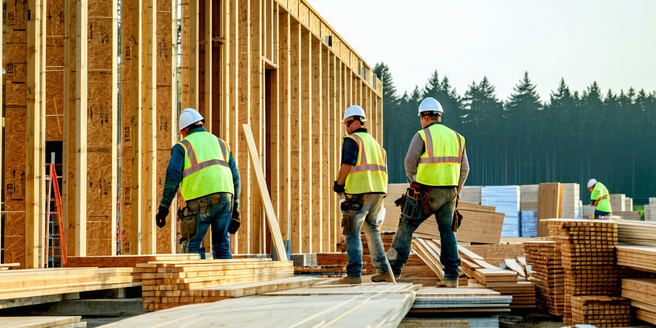Innovative Building Materials for Cost-Effective Homes
Innovative building materials are transforming the affordable housing landscape, making cost-effective home construction more feasible. Materials like engineered wood, recycled plastics, and sustainable concrete alternatives offer durability matched with cost-effectiveness. These materials not only reduce construction costs significantly but also lower maintenance expenses over time. Furthermore, their sustainable nature contributes to reducing the overall carbon footprint of new housing projects. Construction technologies are evolving to integrate these materials seamlessly, enabling rapid, high-quality construction. Builders and developers are increasingly adopting these materials to meet the growing demand for affordable housing. This trend highlights the potential for innovation to address the affordable housing crisis efficiently, making home ownership more accessible to diverse demographics. As these materials become more mainstream, we can expect a profound impact on the housing market, driving both affordability and sustainability.
The Rise of Tiny Homes in Urban Areas
The tiny home movement is gaining momentum in urban areas, offering a novel solution to housing shortages and high living costs. These compact, efficient spaces maximize limited urban footprints while minimizing environmental impact. Tiny homes challenge traditional living concepts, focusing on minimalism and functionality, making them desirable for urban dwellers seeking affordability and simplicity. Cities recognize this trend, adjusting zoning laws to accommodate tiny home communities, further driving their popularity. As property prices soar and urban populations grow, tiny homes provide a practical, cost-effective housing alternative. Their rise reflects a shift in cultural attitudes toward ownership, sustainability, and lifestyle choices. While tiny homes may not replace traditional residences, their increasing adoption in urban landscapes suggests a redefining of urban living norms, making homeownership more attainable for a broader population segment.
Community-Focused Urban Planning Initiatives
Urban planning strategies are increasingly incorporating community-focused initiatives, emphasizing the significance of affordable housing in vibrant cityscapes. These plans prioritize inclusive housing that reflects local needs, fostering community cohesion. Planners are engaging residents in the decision-making process, ensuring developments are a true reflection of the community’s identity and requirements. This participatory approach results in neighborhoods that support diverse housing options, access to essential services, and green spaces. Innovative approaches such as mixed-income housing developments and zoning adjustments are utilized to create inclusive urban environments. These initiatives strive to balance development with the preservation of community character, ensuring the benefits of urban growth are shared equitably. By fostering collaboration between stakeholders, urban planning processes can effectively address the challenges of affordable housing and promote sustainable, inclusive growth in cities.
Technological Innovations in Affordable Housing
Technological advancements are revolutionizing affordable housing, enhancing construction efficiency while reducing costs. Automation and advanced manufacturing techniques, such as 3D printing, are enabling faster, more precise building processes, significantly lowering labor costs. Smart home technologies offer energy savings and better resource management, making homes more sustainable and reducing ongoing living expenses for residents. These innovations are critical in addressing the gap between demand and supply in the affordable housing sector. Digital planning tools facilitate more effective project management, ensuring time-efficient and cost-effective construction. The increased use of data analytics allows developers to position projects strategically, optimizing accessibility and convenience for residents. As technology continues to evolve, its integration into affordable housing strategies is likely to expand, offering new solutions to housing challenges and making homes more accessible to a diverse range of individuals and families.
Public-Private Partnerships Boosting Housing Availability
Public-private partnerships (PPPs) are crucial in boosting affordable housing availability by pooling resources, expertise, and funding to develop housing projects. Governments collaborate with private developers to fast-track construction and manage costs effectively. These partnerships benefit from the efficiency of the private sector, combined with public sector oversight ensuring projects align with affordable housing goals. PPPs facilitate access to government incentives, grants, and land, minimizing financial risks for developers while maximizing community benefits. They enable innovative financing solutions and ensure diverse housing options, catering to different income levels. Through these collaborations, affordable housing developments achieve higher quality standards and quicker completion rates. By addressing both supply and demand challenges, PPPs play a vital role in creating sustainable urban environments and improving housing accessibility. The continued growth of these partnerships is essential in overcoming housing shortages and meeting the increasing demand for affordable homes.
Challenges and Solutions in Affordable Housing Development
Affordable housing development faces numerous challenges, including regulatory hurdles, high land prices, and financing difficulties. Overcoming these barriers requires a multifaceted approach. Streamlining zoning laws and building codes can reduce bureaucratic delays, enabling faster project approvals. Public policies offering tax incentives and subsidies to developers can offset land costs and encourage investment in affordable housing. Collaborative efforts between governments, financial institutions, and community organizations are essential for securing funding and resources. Innovative construction techniques, such as modular building and off-site manufacturing, can lower costs and expedite completion. Enhancing community engagement ensures new developments meet local needs and gain public support. These solutions require coordinated efforts to effectively increase the supply of affordable housing. Adapting to evolving economic and demographic landscapes is crucial for sustainable progress in affordable housing, making it accessible and viable for future generations.



